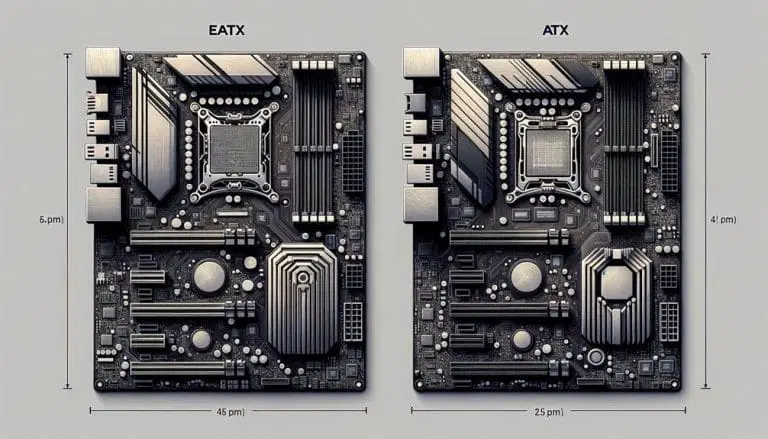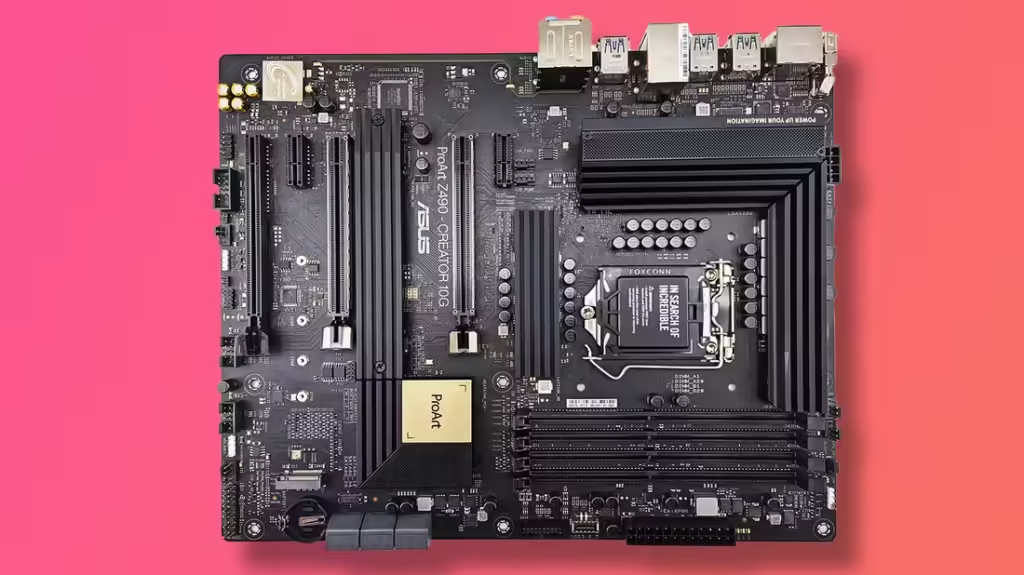Eatx vs atx Any computer system’s backbone is its motherboard, hence selecting the correct form factor is essential to create a system fit for your particular requirements. Two of the most often used choices are the Advanced Technology eXtended (ATX) and Extended ATX (EATX) forms. Both are extensively utilized in building high-performance desktop systems, however depending on the needs of your build, their variances may affect your choice. We will go over the variations between EATX and ATX motherboards in this all-inclusive guide, examine their performance, fit for different uses, and address often asked concerns. This post will help you to clearly know which motherboard form factor would be best for your next PC construction by the end.
Motherboards for E-ATX and ATX:
Understanding what EATX and ATX motherboards are will help you appreciate the comparison later on. Intel created Advanced Technology eXtended, or ATX, in 1995 and now it is the standard form factor for motherboards in desktop computers. Measuring 305mm x 244mm (12 inches x 9.6 inches), the typical ATX motherboard For a wide spectrum of uses from gaming to professional workstations, it provides a decent mix between size, expandability, and performance.
Measuring 305mm by 330mm (12 inches × 13 inches), EATX, or Extended ATX, is a larger variation of the ATX form factor. EATX motherboards’ greater capacity lets them handle more components—including storage choices, PCI slots, and RAM slots. High-end gaming systems, server environments, and professional workstations where expandability and performance are most valued frequently feature EATX motherboards.
Key Differences: EATX vs. ATX
Dimensions and Organization
The size of EATX and ATX motherboards is among the most clear variations between them. Although the EATX motherboard is much bigger than the ATX, both benefits and drawbacks follow from this.
EATX vs. ATX Size Comparison
| Motherboard Type | Dimensions (mm) | Dimensions (inches) |
|---|---|---|
| ATX | 305 x 244 | 12 x 9.6 |
| EATX | 305 x 330 | 12 x 13 |
More components—including extra PCIe slots and RAM slots—can be placed on the EATX motherboard’s bigger footprint. This implies, meanwhile, that the EATX calls for a bigger casing, which can restrict your options for computer cases. Furthermore, especially in compact cases, the bigger size could cause somewhat more challenging cable management.
Expandability
Those that require a highly customized system depend critically on expandability. Given their greater size, EATX motherboards usually provide more expandability than ATX motherboards. This covers more storage possibilities, extra PCIe slots for several GPUs, and more RAM slots—up to 8 or more.
EATX vs. ATX Expandability
| Feature | ATX | EATX |
|---|---|---|
| RAM Slots | 4 to 8 | 8 to 16 |
| PCIe Slots | 3 to 5 | 5 to 7 |
| M.2 Slots | 1 to 3 | 2 to 4 |
| SATA Ports | 4 to 6 | 6 to 10 |
The expandability presented by an EATX motherboard might be rather helpful for consumers assembling a server or a high-performance workstation. For most general-purpose systems, though, an ATX motherboard provides more than enough expandability.
Performance
- Regarding performance, both EATX and ATX motherboards can handle premium components like the most recent CPUs, GPUs, and RAM. Still, in some situations EATX motherboards’ larger size and expandability help to improve performance.
- For jobs requiring a lot of graphics processing capability, such 3D rendering, video editing, and gaming, an EATX motherboard’s capacity to support several GPUs makes it perfect. Applications needing a lot of memory, including virtualization and database administration, may also benefit from the extra RAM slots.
- Having said that, an ATX motherboard is a perfect fit for basic computing, multimedia creation, and gaming as most high-performance components are more than fit for it.
For gaming, which is better—EATX or ATX?
Among the main uses for both EATX and ATX motherboards are gaming. Still, your particular gaming requirements and money will determine which of the two best fit you.
ATX for Gaming
Most gaming builds would find ATX motherboards fit. They provide enough PCIe slots for a high-end GPU, enough RAM slots, and enough storage options, thereby striking a decent mix of features. An ATX motherboard will offer most players all the tools they need to run contemporary games at high settings.
EATX for Entertainment: Gaming
Gamers that require more features and expandability will find EATX motherboards perfect. This covers support for many GPUs, extra RAM slots for greater capacity, and more storage choices. Gamers that wish to create an aggressive gaming machine with specialized water cooling, several graphics cards, and overclocked CPUs generally select EATX motherboards.
EATX motherboards are often more costly than ATX motherboards, however this is notable. Furthermore, the bigger EATX board size indicates that you will require a compatible casing, which could raise the whole building cost.
EATX against ATX: Uses and Comparisons
Workstations
Because of its expandability, an EATX motherboard is usually the preferable option for professional workstations especially those utilized for jobs such CAD, video editing, and 3D rendering. EATX is perfect for resource-intensive applications since it allows one to add more RAM, more GPUs, and extra storage.
Servers
EATX motherboards are the go-ahead choice in server applications, where dependability and expandability rule. EATX motherboards fit for server work thanks to extra room for more RAM, additional CPUs (in dual-socket boards), and more storage options.
Residential and Business Use
Usually more than enough for regular home and business use is an ATX motherboard. For regular chores including online surfing, workplace apps, and light gaming, it provides enough expandability. Furthermore more reasonably priced and readily available, ATX motherboards are a common choice for daily computing requirements.
EATX compared to ATX:
Availability and Cost
The features, brand, and form factor all help to greatly affect the cost of a motherboard. Because of their greater size and more capabilities, EATX motherboards are typically more costly than ATX motherboards.
EATX vs. ATX Pricing Comparison
| Motherboard Type | Price Range (USD) |
|---|---|
| ATX | $100 to $400 |
| EATX | $250 to $600+ |
With a larger selection of models to pick from, ATX motherboards are also more often accessible. This facilitates the search for an ATX motherboard appropriate for your demands and budget. Though they have greater capabilities, EATX motherboards are less common and more difficult to locate, particularly in lower price ranges.

FAQs
EATX and ATX motherboards differ mostly in this aspect?
EATX and ATX motherboards vary mostly in size and expandability. Larger and with more functionality like more RAM slots, PCIe slots, and storage choices, EATX motherboards Smaller, more reasonably priced ATX motherboards provide enough capability for most general-purpose projects.
For gaming, is an EATX motherboard worth it?
If you intend to create an advanced gaming setup with several GPUs, overclocked CPUs, and specialized cooling solutions, an EATX motherboard is well worth it. For most gamers, though, an ATX motherboard will offer all the required capabilities at a reduced cost.
Can a basic ATX case fit an EATX motherboard?No, usually an EATX motherboard calls for a larger case that fits the EATX form factor. Extra width of an EATX motherboard is not something standard ATX cases are made to allow.
An ATX motherboard offers what benefits?
An ATX motherboard offers smaller size, less cost, and enough expandability for most users among other benefits. Because ATX motherboards are so frequently used in general computing, gaming, and office environments they are a preferred choice.
An EATX motherboard has advantages what ones?
Greater expandability, various GPU support, extra RAM slots, and more storage options define an EATX motherboard. For high-performance workstations, servers, and extreme gaming configurations EATX motherboards are perfect.
Do EATX motherboards cost more than ATX motherboards?
Indeed, EATX motherboards have more features and a greater size than ATX motherboards, which makes them usually more costly. The brand, features, and model will all affect the price variance.
Final Words
When deciding between EATX and ATX motherboards, take your particular requirements, budget, and building goal into serious thought. Extreme gaming systems, servers, and high-end workstations all find EATX motherboards perfect for their exceptional expandability and performance. They demand bigger cases and cost more, though. Conversely, ATX motherboards fit most general-purpose projects, gaming, and daily computing chores since they offer a decent mix of capabilities, cost, and size.
Choose an EATX or ATX motherboard such that it fits your performance needs and future upgrade schedule. By making the correct decision, you may create a system that satisfies your needs and provides the desired performance.

